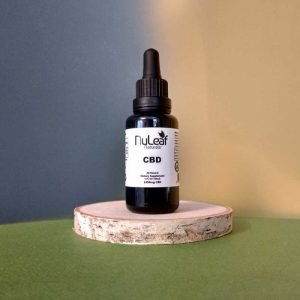Twelve percent of the US population suffers from an illness with symptoms that can include pulsing pain, blurred vision, and nausea.
Migraine headaches aren’t just debilitating, they’re surprisingly common, and most people who experience them never seek medical help.
Anecdotal evidence suggests that some people successfully use CBD oil for migraines. But does it really work?
Read on to find out what the current research says.
About CBD Oil for Migraines
Claim
CBD prevents and/or cures migraines.
Research Shows
While some researchers think that CBD holds promise for treating migraines, there haven’t been any clinical trials specifically looking at the efficacy of CBD as a migraine treatment.
Just the Facts
With its pain-relieving and anti-inflammatory properties, CBD may help some people with migraines. As of yet, though, the support for this claim is largely anecdotal.
About Migraines
According to the Migraine Research Foundation, migraines are the world’s sixth most disabling illness. One out of four American households includes at least one person who suffers from migraines.
These pulsing headaches usually occur on one side of the head. They can last for hours or even days, and are often accompanied by other symptoms, like:
- Visual disturbances like flashing lights or zig zags
- Blurred vision
- Nausea
- Sensitivity to light and sounds
- Lightheadedness
Best CBD Oils
Looking for the best CBD oils out there? These are just a few examples of trusted brands that we’ve fully vetted for quality:
Or, you can check out our full ranking of the 20 Best CBD Oils for 2019.
Migraines aren’t well understood, and treatment options are either focused on preventing headaches, or on relieving the pain when headaches occur.
Many people rely on over-the-counter pain relievers for migraine relief, but there are many other methods for the treatment of migraines. These can range from lifestyle changes to botox injections — or even opioid medications.
How CBD Could Help with Migraines
Before it became prohibited in the United States, physicians frequently used preparations derived from the cannabis plant to treat migraines. In fact, from 1842 to 1942, doctors preferred cannabis over other types of treatments for these severe headaches.
But CBD is just one component of cannabis. How might it work to treat migraines?
CBD, or cannabidiol, is one of many cannabis-derived substances called cannabinoids. Tetrahydrocannabinol, or THC, is another member of this group that is famous for its psychoactive properties. CBD, on the other hand, is non-intoxicating, so it doesn’t cause the same mind-altering effects.
In the body, cannabinoids interact with a network of chemicals and receptors known as the endocannabinoid system (ECS). They’re able to do this because they closely resemble chemicals that the body naturally produces.
The ECS includes cannabinoid receptors that are found throughout the body, in locations as varied as the brain, organs, and immune system cells. It plays a role in regulating various processes, from mood to cellular life cycles.
Clinical trials haven’t yet determined whether CBD is an effective treatment for migraines. Still, there are a few reasons to think that CBD might work for some people.
The research on using CBD for pain in general is much more robust, and has shown that CBD increases levels of the neurotransmitters glutamate and serotonin. These are both thought to play a role in pain regulation.
CBD has anti-inflammatory properties, and that may indirectly help with pain by dealing with its cause. In addition, some researchers have suggested that CBD could be used to counteract some of the vascular phenomena that are associated with migraines.
Finally, there is a wealth of anecdotal evidence from people who use CBD to treat their migraines. Some chronic migraine sufferers say they’ve seen a substantial reduction in their headaches.
Research Highlights
We’ve summarized a few of the studies that are relevant to using CBD oil for migraines. Read on to learn more.
2018: Medical Cannabis Usage Patterns for Migraine
The authors of a paper published in the Journal of Headache and Pain surveyed medical marijuana users who suffered from migraines.
Those who smoked or vaporized their cannabis preferred high-THC, low-CBD strains. On the other hand, patients who chose to ingest capsules or oils tended to select high-CBD products.
It’s important to note that this study did not evaluate the efficacy of different strains. Rather, it looked at patients’ preferences, which could be influenced by a number of other factors like cost or availability.
In general, patients reported reducing prescription medications like opioids when using medical cannabis.
2016: Endocannabinoid Deficiency and Migraine
This paper considered the possibility that an endocannabinoid deficiency could be implicated in a range of chronic illnesses, like migraine, fibromyalgia, irritable bowel syndrome, and other hard-to-treat conditions.
The author specifically proposes CBD as a treatment for migraines and says that clinical trials using high-CBD strains of cannabis are “long overdue.”
1987: Cannabis for Migraine Prevention
This paper followed three cases in which long-term cannabis users began experiencing migraines after abruptly stopping cannabis use.
The paper’s author suggested that this phenomenon might indicate that cannabis has a preventative effect for migraines, and called for additional research investigating cannabinoid-based treatments.
Concerns About Using CBD Oil for Migraines
Most experts agree that CBD is probably safe to use. In fact, the World Health Organization (WHO) recently reclassified CBD, saying that it has multiple potential medical applications with little potential for abuse.
Patients in clinical trials have experienced very few adverse side effects when using CBD oil. But the ones that have occurred have sometimes been the result of interactions with other drugs. That’s because a group of liver enzymes known as cytochrome P450 (CYP) metabolizes CBD. These enzymes also break down a lot of common medications.
So, if you take other medications for migraine pain, adding CBD to your regimen could make your medication’s effects feel more or less intense than usual.
Always talk to your doctor before you start using CBD oil for migraines, especially if you’re taking other medications. Your physician may want to adjust your dosage to compensate for CYP interactions.
You should also be aware that some people report that CBD either doesn’t help with their migraines, or that it actually triggers them. That could be because of the CBD itself, or because of another ingredient in the products that people use.
When you are considering a CBD product, read the ingredients closely. Avoid anything that contains ingredients that you know trigger your migraines.
Editor's Choice: CBD Oil Drops
Ready to add a good CBD oil to your routine? Check out a few of our team’s top choices, or check out this year’s ranking of the Best CBD Oil Drops.
RE Botanicals, Hemp 25 Classic Tincture
Founded by a veteran of the hemp industry and an advocate for regenerative agricultural practices, RE Botanicals is one of the first CBD brands to qualify for organic certification from the USDA — and they beat many of their competitors on pricing!
Save 10% with code: cbdhacker.
Mission Farms, Relax CBD Oil
Mission Farms formulates their full spectrum CBD products with essential oils and terpenes to address different concerns. And with formulas designed to aid in relaxation, sleep, and pain relief, they have something for just about everyone!
Save 20% with code: cbdhacker.
NuLeaf Naturals, Full Spectrum CBD Oil
NuLeaf Naturals offers Colorado-grown, full spectrum CBD oil that offer among the most trace cannabinoids per drop of any product we’ve tested.
Save 20% with code: cbdhacker.










